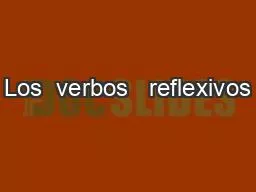

Reflexive verbs In this presentation we are going to look at a special group of verbs called reflexives Lets start out by thinking of the English verb to wash List several things that you can wash ID: 794359
Download The PPT/PDF document "Los verbos reflexivos" is the property of its rightful owner. Permission is granted to download and print the materials on this web site for personal, non-commercial use only, and to display it on your personal computer provided you do not modify the materials and that you retain all copyright notices contained in the materials. By downloading content from our website, you accept the terms of this agreement.
Slide1
Los verbos reflexivos
Slide2Reflexive verbsIn this presentation, we are going to look at a special group of verbs called
reflexivesLet’s start out by thinking of the English verb
‘to wash.’ List several things that you can wash.
Slide3Some examplesI wash my clothes
I wash the dishesI wash the carI wash the windows
I wash my handsI wash my hair
Slide4What’s the difference?I wash the car.
I can wash things that are not part of me, that is, they are not part of my body.
In Spanish, we say: Yo lavo el carro.
Slide5…and…I also wash things on my body:
hands, face, hair…
I wash my hands. in Spanish we say:
Me lavo las
manos.
Slide6Huh?
There are two ways to talk about washing in Spanish.First, to wash something else.
Second, to wash part of one’s body.
Slide7And your point is…?
If you are washing something that is attached to your body, you need to add the word me
Me lavo las manos
Slide8You need these pronounsme
nos
te osse
se
Slide9Lavarse conjugated:
Me lav
o nos lavamosTe lavas
os laváis Se lavase
lavan
The endings are still the same. In this
case,
these are endings for regular “
ar
” verbs in the present tense.
Slide10Notice the placement of the reflexive pronouns in Spanish:
Sue bathes herself.
reflexive pronoun
subject
Sue
Sue se baña.
reflexive pronoun
subject
Slide11How do you get those forms?The infinitive has
se attached to it to show that
the subject is doing something to him
/herself in order to
get ready. Drop the ‘se’Change
the verb ending
Put
the
appropriate
-
ar
,
-
er
,
or
–ir
conjugation
of
the
verb
.
Add the appropriate reflexive pronoun in front of the conjugated verb.
Slide12Let’s try one
Llamarse: to call oneselfYo
me llamoTú te llamas
Él se llama
Nosotros nos llamamosVosotros os llamáis
Ellos se llaman
The
verb
endings
are
the
usual
ones
!!
Slide13Some more reflexive verbs…
Levantarse: to get up/
to stand up.Sentarse (ie): to sit down
Ponerse (-go verb):
to put on an article of
clothingDormirse (ue):
to
fall
asleep
Slide14LevantarseYo me
levantoTú te levant
asÉl se levantaNosotros nos levantamosVosotros
os levantáisEllos
se levantan
Slide15Sentarse (ie)Yo
me siento
Tú te sientasÉl se sie
ntaNosotros nos sent
amosVosotros os sentáisEllos se sient
an
Slide16Ponerse (-go verb)Yo me pongoTú
te ponesÉl se
poneNosotros nos ponemosVosotros os ponéisEllos
se ponen
Slide17Dormirse (ue)
Yo me duermoTú
te duermesÉl se duermeNosotros nos dormimos
Vosotros os dormís
Ellos se duermen
Slide18Dormir vs. DormirseThe verb
forms are the same
: duermo, duermes, duerme, dormimos, dormís, duermenThe difference in form is the
addition of the
reflexive pronouns: me, te, se, nos, os, seThe difference in meaning
is:Dormir is
to
sleep
Dormirse
is
to
fall
asleep
Slide19A verb followed by a reflexive verb:
Remember that in a sentence
when there are 2 verbs next to each other, you conjugate
the first verb and leave the
second verb in its regular form. (Ex. Yo necesito trabajar.) The rule
is a little different when a verb
is
followed
by
a
reflexive
verb
.
*
Instead
of
placing
the
reflexive
pronoun
in
front
of
the
verb
,
you
will
leave
it
attached
to
the infinitive and
change it so that
it agrees with the subject
.
Some
examples
: Tú necesitas levantar
te
. / Yo necesito maquillar
me
. / Ana necesita levantar
se
.
Slide20A morning routineTodos los días, yo ______________
(levantarse) a las 7:00. __________ (ir) al baño, ____________
(lavarse) la cara, y __________ (afeitarse). Luego ___________ (vestirse (i)) y __________(comer) un poco de desayuno. Por fin, ____________(cepillarse) los dientes.
me levanto
Voyme lavo
me
afeito
m
e
visto
como
m
e
cepillo
Slide21Let’s do anotherJuana ____________(despertarse (ie) a las 6:30 y __________(levantarse). ________ (ir) al baño, y __________(ducharse). Ella ____________(secarse), _______(peinarse) y ________________(maquillarse).
se
despiertase levantaVa
se
duchase secase
peinase
maquilla
Slide22Whew! That’s a lot to rememberTrue! But keep in mind that the verb changes as it always does. You just have to remember to use the reflexive pronouns (me,
te, se, nos, os, se)
if you see an infinitive that ends in ‘se’